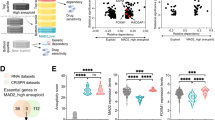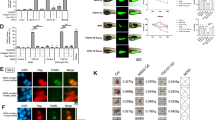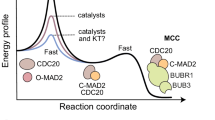Abstract
The spindle assembly checkpoint (SAC) is a ‘wait-anaphase’ mechanism that has evolved in eukaryotic cells in response to the stochastic nature of chromosome–spindle attachments. In the recent past, different aspects of the SAC regulation have been described. However, the role of microRNAs in the SAC is vaguely understood. We report here that Mad1, a core SAC protein, is repressed by human miR-125b. Mad1 serves as an adaptor protein for Mad2 – which functions to inhibit anaphase entry till the chromosomal defects in metaphase are corrected. We show that exogenous expression of miR-125b, through downregulation of Mad1, delays cells at metaphase. As a result of this delay, cells proceed towards apoptotic death, which follows from elevated chromosomal abnormalities upon ectopic expression of miR-125b. Moreover, expressions of Mad1 and miR-125b are inversely correlated in a variety of cancer cell lines, as well as in primary head and neck tumour tissues. We conclude that increased expression of miR-125b inhibits cell proliferation by suppressing Mad1 and activating the SAC transiently. We hypothesize an optimum Mad1 level and thus, a properly scheduled SAC is maintained partly by miR-125b.
Similar content being viewed by others
Log in or create a free account to read this content
Gain free access to this article, as well as selected content from this journal and more on nature.com
or
Abbreviations
- miRNA:
-
microRNA
- hsa-miR:
-
Homo sapiens miRNA
- mRNA:
-
messenger RNA
- SAC:
-
spindle assembly checkpoint
- MAD:
-
mitotic-arrest deficient
- CIN:
-
chromosomal instability
- APC/C:
-
anaphase-promoting complex/cyclosome
- Cdc20:
-
cell division cycle 20
- BUB:
-
budding uninhibited by benzimidazole
- MCC:
-
mitotic checkpoint complex
- C-Mad2:
-
closed Mad2
- O-Mad2:
-
open Mad2
- HNOC:
-
head and neck/oral cancer
- UTR:
-
untranslated region
- SCC:
-
squamous cell carcinoma
- Mut:
-
mutant
- Luc:
-
luciferase
- p-H3:
-
phosphorylated histone H3
- MI:
-
mitotic index
- PI:
-
propidium iodide
References
Bartel DP . MicroRNAs: genomics, biogenesis, mechanism, and function. Cell 2004; 116: 281–297.
Friedman RC, Farh KK, Burge CB, Bartel DP . Most mammalian mRNAs are conserved targets of microRNAs. Genome Res 2009; 19: 92–105.
Griffiths-Jones S . The microRNA Registry. Nucleic Acids Res 2004; 32: D109–D111.
Hwang HW, Mendell JT . MicroRNAs in cell proliferation, cell death, and tumorigenesis. Brit J Cancer 2006; 94: 776–780.
Dalmay T, Edwards DR . MicroRNAs and the hallmarks of cancer. Oncogene 2006; 25: 6170–6175.
Lu J, Getz G, Miska EA, Alvarez-Saavedra E, Lamb J, Peck D et al. MicroRNA expression profiles classify human cancers. Nature 2005; 435: 834–838.
Rosenfeld N, Aharonov R, Meiri E, Rosenwald S, Spector Y, Zepeniuk M et al. MicroRNAs accurately identify cancer tissue origin. Nat Biotechnol 2008; 26: 462–469.
Hanahan D, Weinberg RA . Hallmarks of cancer: the next generation. Cell 2011; 144: 646–674.
Kops GJ, Weaver BA, Cleveland DW . On the road to cancer: aneuploidy and the mitotic checkpoint. Nat Rev Cancer 2005; 5: 773–785.
Musacchio A, Salmon ED . The spindle-assembly checkpoint in space and time. Nat Rev Mol Cell Biol 2007; 8: 379–393.
Nasmyth K . Segregating sister genomes: the molecular biology of chromosome separation. Science 2002; 297: 559–565.
De Antoni A, Pearson CG, Cimini D, Canman JC, Sala V, Nezi L et al. The Mad1/Mad2 complex as a template for Mad2 activation in the spindle assembly checkpoint. Curr Biol 2005; 15: 214–225.
Yu H . Cdc20: a WD40 activator for a cell cycle degradation machine. Mol Cell 2007; 27: 3–16.
Sironi L, Melixetian M, Faretta M, Prosperini E, Helin K, Musacchio A . Mad2 binding to Mad1 and Cdc20, rather than oligomerization, is required for the spindle checkpoint. EMBO J 2001; 20: 6371–6382.
Chung E, Chen RH . Spindle checkpoint requires Mad1-bound and Mad1-free Mad2. Mol Biol Cell 2002; 13: 1501–1511.
Ryan SD, Britigan EM, Zasadil LM, Witte K, Audhya A, Roopra A et al. Up-regulation of the mitotic checkpoint component Mad1 causes chromosomal instability and resistance to microtubule poisons. Proc Natl Acad Sci USA 2012; 109: E2205–E2214.
Barwad A, Sood S, Gupta N, Rajwanshi A, Panda N, Srinivasan R . Human papilloma virus associated head and neck cancer: a PCR based study. Diagn Cytopathol 2011; 40: 893–897.
Minhas KM, Singh B, Jiang WW, Sidransky D, Califano JA . Spindle assembly checkpoint defects and chromosomal instability in head and neck squamous cell carcinoma. Int J Cancer 2003; 107: 46–52.
Ruepp A, Kowarsch A, Schmidl D, Buggenthin F, Brauner B, Dunger I et al. PhenomiR: a knowledgebase for microRNA expression in diseases and biological processes. Genome Biol 2010; 11: R6.
Neumann B, Walter T, Heriche JK, Bulkescher J, Erfle H, Conrad C et al. Phenotypic profiling of the human genome by time-lapse microscopy reveals cell division genes. Nature 2010; 464: 721–727.
Henson BJ, Bhattacharjee S, O’Dee DM, Feingold E, Gollin SM . Decreased expression of miR-125b and miR-100 in oral cancer cells contributes to malignancy. Genes Chromosomes Cancer 2009; 48: 569–582.
Kienitz A, Vogel C, Morales I, Muller R, Bastians H . Partial downregulation of MAD1 causes spindle checkpoint inactivation and aneuploidy, but does not confer resistance towards taxol. Oncogene 2005; 24: 4301–4310.
Bueno MJ, Malumbres M . MicroRNAs and the cell cycle. Biochim Biophys acta 2011; 1812: 592–601.
Shi W, Alajez NM, Bastianutto C, Hui AB, Mocanu JD, Ito E et al. Significance of Plk1 regulation by miR-100 in human nasopharyngeal cancer. Int J Cancer 2010; 126: 2036–2048.
Nakada C, Tsukamoto Y, Matsuura K, Nguyen TL, Hijiya N, Uchida T et al. Overexpression of miR-210, a downstream target of HIF1alpha, causes centrosome amplification in renal carcinoma cells. J Pathol 2011; 224: 280–288.
Huang V, Place RF, Portnoy V, Wang J, Qi Z, Jia Z et al. Upregulation of Cyclin B1 by miRNA and its implications in cancer. Nucleic Acids Res 2011; 40: 1695–1707.
Liang L, Wong CM, Ying Q, Fan DN, Huang S, Ding J et al. MicroRNA-125b suppressesed human liver cancer cell proliferation and metastasis by directly targeting oncogene LIN28B2. Hepatology 2010; 52: 1731–1740.
Klusmann JH, Li Z, Bohmer K, Maroz A, Koch ML, Emmrich S et al. miR-125b-2 is a potential oncomiR on human chromosome 21 in megakaryoblastic leukemia. Genes Dev 2010; 24: 478–490.
Mondal G, Sengupta S, Panda CK, Gollin SM, Saunders WS, Roychoudhury S . Overexpression of Cdc20 leads to impairment of the spindle assembly checkpoint and aneuploidization in oral cancer. Carcinogenesis 2007; 28: 81–92.
Le MT, Teh C, Shyh-Chang N, Xie H, Zhou B, Korzh V et al. MicroRNA-125b is a novel negative regulator of p53. Genes Dev 2009; 23: 862–876.
Nath S, Banerjee T, Sen D, Das T, Roychoudhury S . Spindle assembly checkpoint protein Cdc20 transcriptionally activates expression of ubiquitin carrier protein UbcH10. J Biol Chem 2011; 286: 15666–15677.
Nilsson J . Cdc20 control of cell fate during prolonged mitotic arrest: do Cdc20 protein levels affect cell fate in response to antimitotic compounds? Bioessays 2011; 33: 903–909.
Perez de Castro I, de Carcer G, Malumbres M . A census of mitotic cancer genes: new insights into tumor cell biology and cancer therapy. Carcinogenesis 2007; 28: 899–912.
Weaver BA, Cleveland DW . Aneuploidy: instigator and inhibitor of tumorigenesis. Cancer Res 2007; 67: 10103–10105.
Iwanaga Y, Jeang KT . Expression of mitotic spindle checkpoint protein hsMAD1 correlates with cellular proliferation and is activated by a gain-of-function p53 mutant. Cancer Res 2002; 62: 2618–2624.
Ghose J, Sinha M, Das E, Jana NR, Bhattacharyya NP . Regulation of miR-146a by RelA/NFkB and p53 in STHdh(Q111)/Hdh(Q111) cells, a cell model of Huntington's disease. PloS One 2011; 6: e23837.
Perrone F, Suardi S, Pastore E, Casieri P, Orsenigo M, Caramuta S et al. Molecular and cytogenetic subgroups of oropharyngeal squamous cell carcinoma. Clin Cancer Res 2006; 12: 6643–6651.
Rehmsmeier M, Steffen P, Hochsmann M, Giegerich R . Fast and effective prediction of microRNA/target duplexes. RNA 2004; 10: 1507–1517.
Rhodes DR, Yu J, Shanker K, Deshpande N, Varambally R, Ghosh D et al. ONCOMINE: a cancer microarray database and integrated data-mining platform. Neoplasia 2004; 6: 1–6.
Acknowledgements
We thank Dr. Chitra Mandal and Dr. Keya Chaudhuri (Indian Institute of Chemical Biology, India) for FACS and microscopic analyses, respectively. We are also grateful to Saikat Mukhopadhyay and Eashita Das (Saha Institute of Nuclear Physics, India) for their invaluable help in the bioinformatic-based miRNA studies and FACS analyses, respectively. This work was supported in part by Department of Biotechnology Grants BT/PR/5524/Med/14/649/2004, BT/01/COE/05/04 and Council of Scientific and Industrial Research Grant IAP 001 awarded to Dr. Susanta Roychoudhury. SB is supported by predoctoral fellowship from the University Grants Commission (New Delhi, India). SN, GPM and NB are supported by predoctoral fellowships from the Council of Scientific and Industrial Research (New Delhi, India), while JG is supported by predoctoral fellowship from the Department of Atomic Energy (Mumbai, India).
Author information
Authors and Affiliations
Corresponding author
Ethics declarations
Competing interests
The authors declare no conflict of interest.
Additional information
Edited by RA Knight
Supplementary Information accompanies the paper on Cell Death and Differentiation website
Rights and permissions
About this article
Cite this article
Bhattacharjya, S., Nath, S., Ghose, J. et al. miR-125b promotes cell death by targeting spindle assembly checkpoint gene MAD1 and modulating mitotic progression. Cell Death Differ 20, 430–442 (2013). https://doi.org/10.1038/cdd.2012.135
Received:
Revised:
Accepted:
Published:
Issue date:
DOI: https://doi.org/10.1038/cdd.2012.135
Keywords
This article is cited by
-
Aneuploid abortion correlates positively with MAD1 overexpression and miR-125b down-regulation
Molecular Cytogenetics (2021)
-
Mitotic checkpoint defects: en route to cancer and drug resistance
Chromosome Research (2021)
-
Identification of genetic variation in the lncRNA HOTAIR associated with HPV16-related cervical cancer pathogenesis
Cellular Oncology (2016)
-
Mitotic arrest deficient-like 1 is correlated with poor prognosis in small-cell lung cancer after surgical resection
Tumor Biology (2016)
-
Inhibition of nucleoporin member Nup214 expression by miR-133b perturbs mitotic timing and leads to cell death
Molecular Cancer (2015)



